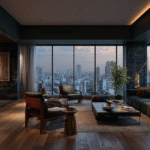You associate your bedroom with sleep. Most of the time spent in the bedroom is for sleeping, but your bedroom may not always be designed for sleep. Instead, your choice of decor could be what is keeping you awake at night.
There are certain factors that go into a sleep-centered bedroom, and we are on hand to make sure you know them all.
Make Sure Your Bed is Positioned Accordingly
Where your bed is positioned may not sound like a big deal, but it can be. Even small adjustments can alter the effect environmental factors have on you. Sunlight may be less likely to reach your face, allowing you to rest longer. Some walls may also be noisier or affected by the opening and closing of doors; moving further away from these will allow a more consistently deeper sleep.

Do You Really Need a TV?
It’s not uncommon for us to try and watch a few episodes of our favorite TV show before going to bed. Many people have a TV in their room, installed with the expectation that the time between turning them off and going to sleep is only a matter of minutes. Of course, it doesn’t work like that—your brain is still active. It’s unlikely to have been given the proper process for settling down.
If you’re going to have your TV anywhere, it should be kept in an active space, such as the living room. It is helpful to think of your bedroom as a place designed for sleep. This consideration should also extend to our phones too. It is often tempting to just reach over and scroll through your phone. Sometimes, it’s not enough to just leave it dormant on the bedside table. Having it within your reach, where it can go off right next to you can throw you off your sleep. Many people are leaving them in other rooms overnight and using a digital alarm clock instead.
Another solution is making sure that your bed is away from a plug socket where your phone is charging, removing temptation, and making it easier for you to get settled.
Choose Your Mattress Wisely
Your mattress is going to represent a make-or-break scenario for your sleep. All mattresses have different effects on different people. Few people realize their mattress is supposed to match their sleeping preferences. An innerspring mattress is one of the most popular and long-lasting options, however, new technology, such as memory foam mattresses, offer better adaptability to your sleeping position, while gel mattresses have been developed to help regulate your body heat. Look through the list by mattress reviews website Savvy Sleeper to find a type suited to you.
Opting for Softer Lighting
Lights within our home may often be extreme and, when little attention is placed upon the type of bulb or shade we install, our bodies may struggle to feel relaxed. The human eye is sensitive, requiring time to adjust. As soon as you turn the light on, your body will adapt to it, meaning a brighter bulb will make you more alert.

Lights with multiple brightness options and dimmers have become popular within bedrooms. They are also very easy to install. However, others are taking to creating their own alternative lighting designs. Running fairy lights underneath a bedframe or trailing them around a window illuminates a room enough to see but keep you feeling cozy enough to relax.
Choose the Right Color Scheme
Whatever color you use for your paint or wallpaper will impact how much sleep you get. A recent survey was carried out that tested how long people slept based on the color of their bedroom. The top five colors were as follows:
- Blue – 7 hours, 52 minutes
- Yellow – 7 hours, 40 minutes
- Green – 7 hours, 36 minutes
- Silver – 7 hours, 28 minutes
- Orange – 7 hours, 28 minutes
A peaceful blue color—preferably navy—is shown to be ideal for a full night of sleep. Some colors, like purples, grays, and brown were even shown to cause averages of only six hours of sleep. Colors that come with sharp, bright contrasts should be avoided. Instead go for softer, paler colors, to create a restful environment.
Regulate Air and Temperature
Temperature is another factor to consider; You don’t want to be too warm—your body’s core temperature may rise, resulting in unpleasant night sweats. If you’re too cold, you may struggle to fall asleep because your body shivers to try and warm itself. Whatever the case, you are much better off with a cooler temperature, around 67 degrees to be exact.
You should also consider investing in a ceiling fan to help regulate temperature. While one may think of this as a possible distraction, this is actually another way that can help improve sleep through the white noise it gives off, which can drone out any disturbances from outside. In fact, the inclusion of white noise in the bedtime routine was elaborated upon in a study revealed that white noise had been used to drone out environmental noises.
Blackout Blinds
In order to get a good night’s sleep, you need to limit your exposure to natural light, especially during the summer period where you’re trying to get settled with a blaring sun in the background. A good set of blackout blinds will block out sunlight and give you greater control over the level of light you are comfortable with.

Appeal to the Senses
Depending on how strong your five senses are, they can be quite distracting when you are trying to get to sleep. If you’re concerned about noises, silicon earplugs are a good option. To further alleviate any hindrance from light, invest in a strong sleep mask. Also, be on the lookout for scents that can help you relax. One such scent is lavender, which can be used to decrease your heart rate and blood pressure. These additions will help you attain a state of peace and tranquillity.
A bedroom should be your safe haven, a place where you can go to relax, not concern yourself with the daily stresses of life. That should be reflected in your decor. You don’t even need to be awake for these benefits. You just need them to prepare you for a night of healthy, undisturbed sleep, so you can be fully revitalized for the next day.






